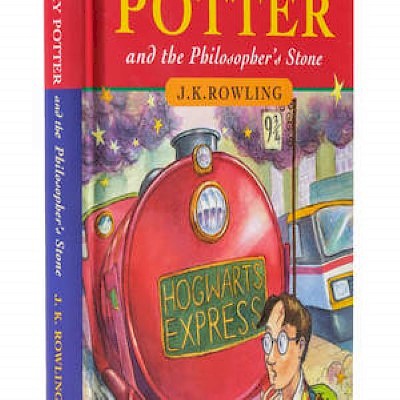DALTON, John (1766-1844). A New System of Chemical Philosophy. Manchester: S. Russell for R. Bickerstaff, 1808 [part 1]; Russell and Allen for R. Bick
Lot 22
About Seller
Hindman
1338 West Lake Street
Chicago, IL 60607
United States
Recognized as the Midwest's leading fine art auctioneers, Hindman Auctioneers has built a worldwide reputation based on a full service approach to the auction business tailored to meet the individual needs of our clients. Coming from a variety of educational backgrounds, specialists bring years of e...Read more
Categories
Estimate:
$10,000 - $15,000
Absentee vs Live bid
Two ways to bid:
- Leave a max absentee bid and the platform will bid on your behalf up to your maximum bid during the live auction.
- Bid live during the auction and your bids will be submitted real-time to the auctioneer.
Bid Increments
| Price | Bid Increment |
|---|---|
| $0 | $25 |
| $500 | $50 |
| $1,000 | $100 |
| $2,000 | $250 |
| $5,000 | $500 |
| $10,000 | $1,000 |
| $20,000 | $2,500 |
| $50,000 | $5,000 |
| $100,000 | $10,000 |
About Auction
By Hindman
Nov 5, 2019
Set Reminder
2019-11-05 11:00:00
2019-11-05 11:00:00
America/New_York
Bidsquare
Bidsquare : Library of a Midwestern Collector
https://www.bidsquare.com/auctions/hindman-auctions/library-of-a-midwestern-collector-4496
Hindman Bidsquare@hindmanauctions.com
Hindman Bidsquare@hindmanauctions.com
- Lot Description
DALTON, John (1766-1844). A New System of Chemical Philosophy. Manchester: S. Russell for R. Bickerstaff, 1808 [part 1]; Russell and Allen for R. Bickerstaff, 1810 [part 2].
2 volumes, comprising parts 1 and 2 of Vol. 1 only (lacking Vol. 2 as often, published in 1827) (225 x 137 mm). 8 engraved plates. (Some light spotting to plates.) Bound in non-uniform contemporary paper-backed plain and marbled boards, printed spine labels and stencilled volume numbers, uncut (hinges starting and some light chipping to spine with a few discreet repairs to Vol. I, Pt. I, some light wear); red morocco folding case gilt. Provenance: Dr. Cleghorn (presentation inscriptions from the author); New College, Edinburgh (“Bibliotheca Coll. Nov. Edinensis” stamp on title-page). FIRST EDITION, PRESENTATION COPY, inscribed by Dalton: “Dr. Cleghorn with respects from the Author.”
DALTON’S CLASSIC WORK ON THE ATOMIC THEORY OF MATTER IN ORIGINAL BOARDS. Dalton maintained that all matter was composed of indivisible atoms of various weights, and that each weight corresponded with one of the chemical elements. His was the first chemical atomic theory “to give significance to the relative weights of the ultimate particles of all known compounds, and to provide a quantitative explanation of the phenomena of chemical reaction” (Norman 575). His work prompted him to construct the FIRST PERIODIC TABLE OF ELEMENTS (plate 4 in Vol. I, part 1 facing p. 219). “Dalton reconstructed Newton’s speculations on the structure of matter, and, applying them in a new form to chemistry, gave Lavoisier’s reformation of that science a deeper significance…The identity of each atom was established by its particular weight…Hence the problem of chemical composition was that of determining how many atoms, and of what kinds, entered into the unit, later known as the molecule, of each compound substance. This problem dominated nineteenth-century chemistry” (PMM 261). “His equation of the concepts ‘atom’ and ‘chemical element’ was of fundamental importance, as it provided the chemist with a new and enormously fruitful model of reality” (Norman). Dibner Heralds of Science 44; Grolier/Horblit 22.
For condition inquiries please contact Gretchen Hause at gretchenhause@hindmanauctions.comCondition
- Shipping Info
-
Please refer to https://hindmanauctions.com/shipping-packing
-
- Buyer's Premium



 EUR
EUR CAD
CAD AUD
AUD GBP
GBP MXN
MXN HKD
HKD CNY
CNY MYR
MYR SEK
SEK SGD
SGD CHF
CHF THB
THB![DALTON, John (1766-1844). A New System of Chemical Philosophy. Manchester: S. Russell for R. Bickerstaff, 1808 [part 1]; Russell and Allen for R. Bick](https://s1.img.bidsquare.com/item/l/5264/5264171.jpeg?t=1IdVvz)
![DALTON, John (1766-1844). A New System of Chemical Philosophy. Manchester: S. Russell for R. Bickerstaff, 1808 [part 1]; Russell and Allen for R. Bick](https://s1.img.bidsquare.com/item/s/5264/5264171.jpeg?t=1IdVvz)














